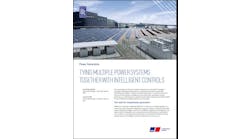10 Lessons Learned from Successful Community Microgrids
Steve Hoffman, CEO of Hoffman Power Consulting, describes the best practices that have emerged from successful U.S. community microgrids. These offer a roadmap for the next generation of community microgrids.
Steve Hoffman, president and CEO of Hoffman Power Consulting
Despite their many benefits, community microgrids face myriad regulatory, financial, and institutional barriers to implementation. Yet, in six cities in diverse regions across the U.S., project teams have defied the odds and found a way to make them work. A careful look at the following six successful prototypes provides useful best practices that project developers, communities, utilities, and regulators can implement in the next generation of community microgrids:
- The Bronzeville community microgrid in Chicago
- The Marcus Garvey Village microgrid in Brownsville, Brooklyn (New York)
- The Reynolds Landing community microgrid near Birmingham, Alabama
- The Parkville (Hartford) Connecticut community microgrid
- The Blue Lake Rancheria community microgrid in Northern California
- The Borrego Springs (California) community microgrid
Define the resilience threat
While microgrids can reduce electricity costs, generate revenue, and maintain high power reliability, they can also enhance community resilience to extreme weather and wildfires. Defining these threats, and positioning the community microgrid as a way to mitigate them, can enhance the likelihood of project approval. For example, in Hartford, Connecticut, Hurricane Irene and soon thereafter a Nor’easter in October 2011 disrupted power to 750,000 homes – many for 11 days. To enhance resilience to storms like these, the city worked with Constellation Energy to develop a fuel cell-based community microgrid in its Parkville neighborhood.
Integrate distributed renewables
The next generation of community microgrids can benefit from implementing these ten best practices identified in the first six successful U.S. community microgrids.
Local renewable generation such as hardened rooftop photovoltaics (PV) is resilient due to its lack of dependence on non-local fuels. This attribute, combined with its availability and decreasing cost, utility incentive plans, government tax incentives, and various clean energy mandates, makes it ideal for a community microgrid. San Diego Gas and Electric Company’s Borrego Springs Microgrid, for example, incorporates a 26-MW central PV system and 3 MW of customer-owned rooftop PV systems.
Integrate improved building energy efficiency
Within a community microgrid, increasing the energy efficiency of buildings reduces the amount and cost of distributed generation and storage capacity needed to power the microgrid in island mode. Building energy efficiency also aids resilience to extreme events because it delays depletion of on-site energy resources. Alabama Power incorporated various home energy-efficient systems (tight building envelope, duct sealing, triple pane windows, heat pump water heaters, and more) in the Reynold’s Landing community microgrid outside Birmingham, Alabama.
Create an “oasis” community microgrid
A community microgrid can act as a refuge or oasis for its citizens during an extreme event. A community center or school in the microgrid can enable residents to gather information and support, recharge their cell phones and EVs, and obtain emergency fresh food and water, etc. This first microgrid in the community can act as a demonstration project that increases awareness and lays the groundwork for additional community microgrids in the city or county. For example, the Hartford community microgrid powers a school, community center, gasoline station, and grocery store during an extreme event.
Medical care is also a crucial element of an oasis community microgrid. The Blue Lake Rancheria Microgrid in Northern California was credited with saving multiple lives during October 2019 outages by powering hotel rooms for critically ill hospital patients who required electrical medical equipment.
Incorporate community education
(Image: Courtesy of Hoffman Power Consulting)
Incorporating community education into community microgrid projects can enhance their usefulness, as well as likelihood of regulatory approval and success. This approach increases awareness of microgrid benefits for local regulatory and government agencies, community and neighborhood leaders, citizens, local businesses, investors, and the media. One notable example is the Bronzeville Community Microgrid that Commonwealth Edison Company (ComEd) is installing on the south side of Chicago. This project obtained regulatory approval in part for its learning benefits, which were enhanced by locating it near (and planning to interconnect it with) an existing university microgrid (the Illinois Institute of Technology).
Optimize site selection
Community microgrid site selection can be a complex task. In the Bronzeville project, ComEd used the U.S. Public Land Survey System to divide its service territory into nearly 13,000 subsections. The utility then evaluated each of these according to existing reliability, capacity for future growth, substation condition, and critical infrastructure that requires enhanced resilience.
Tie to an existing microgrid
To enhance community-wide resilience, each community may ultimately need multiple integrated microgrids. With this goal in mind, demonstration of interconnected microgrids is beneficial. The first utility-operated microgrid “cluster,” ComEd’s Bronzeville project will be able to share resources with the adjacent microgrid serving the Illinois Institute of Technology.
Provide benefits to traditionally-underserved parts of the community
Traditionally-underserved populations in communities are typically more vulnerable to extreme events, can be more impacted by these events, and have fewer options for coping with them when they occur. Hence resilience solutions, such as community microgrids, need to address the needs of these neighborhoods. In one example of this, Consolidated Edison Company of New York is now operating a microgrid at the Marcus Garvey Village affordable housing complex in Brownsville, Brooklyn. The microgrid is a small community itself, incorporating a community center with priority power when in island mode.
Integrate vehicle-to-building/microgrid storage
Although not widely deployed in existing community microgrids, EV charging provides a way to further enhance microgrid resilience. In addition to helping ensure residents’ mobility during an outage, recharged EVs can supply power back to a home or other building in the microgrid (vehicle-to building resilience) and supply power and grid services to the entire microgrid (vehicle-to-microgrid resilience). According to a 2016 Rocky Mountain Institute study, the 60-kWh battery in the Tesla Model 3 stores enough energy to power an average home for two days.
Use the energy-as-a-service model
Also not widely used in existing community microgrids, the energy-as-a-service (EaaS) business model can enable communities, energy users, and other project beneficiaries to avoid the need for project upfront capital (CapEx). Third-party ownership of the microgrid enables OpEx spending – which is far preferable for cash-strapped public entities in the wake of Covid-19 spending.
To learn more on this subject, refer to Hoffman’s white paper. Steve Hoffman is president and CEO of Hoffman Power Consulting, which provides client-tailored thought leadership and business content to microgrid developers and others.







